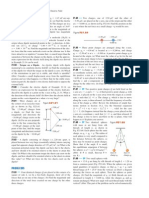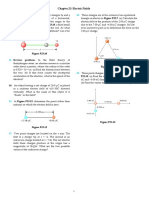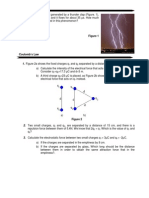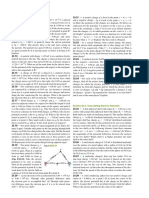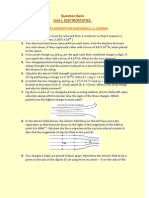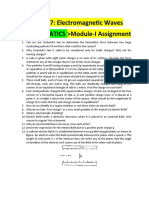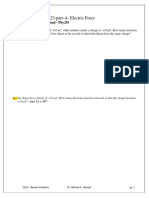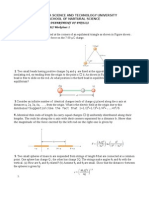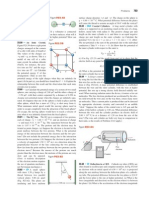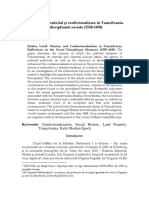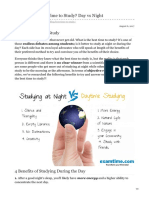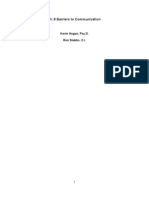Electric Field
Electric Field
Uploaded by
Andres ZerrathoCopyright:
Available Formats
Electric Field
Electric Field
Uploaded by
Andres ZerrathoOriginal Description:
Copyright
Available Formats
Share this document
Did you find this document useful?
Is this content inappropriate?
Copyright:
Available Formats
Electric Field
Electric Field
Uploaded by
Andres ZerrathoCopyright:
Available Formats
Problems
731
7.00 C
+
+q
d/2
0.50 m
60
+
2.00 C
4.00 C
x
d/2
Figure P23.7 Problems 7 and 18.
8. Suppose that 1.00 g of hydrogen is separated into electrons and protons. Suppose also that the protons are
placed at the Earths north pole and the electrons are
placed at the south pole. What is the resulting compressional force on the Earth?
9. Two identical conducting small spheres are placed with their
centers 0.300 m apart. One is given a charge of 12.0 nC
and the other a charge of " 18.0 nC. (a) Find the electric
force exerted by one sphere on the other. (b) What If?
The spheres are connected by a conducting wire. Find
the electric force between the two after they have come to
equilibrium.
10. Two small beads having positive charges 3q and q are fixed
at the opposite ends of a horizontal, insulating rod, extending from the origin to the point x ! d. As shown in
Figure P23.10, a third small charged bead is free to slide
on the rod. At what position is the third bead in equilibrium? Can it be in stable equilibrium?
+q
Figure P23.12
Section 23.4 The Electric Field
13. What are the magnitude and direction of the electric field
that will balance the weight of (a) an electron and (b) a
proton? (Use the data in Table 23.1.)
14. An object having a net charge of 24.0 *C is placed in a uniform electric field of 610 N/C directed vertically. What is
the mass of this object if it floats in the field?
15. In Figure P23.15, determine the point (other than infinity) at which the electric field is zero.
1.00 m
2.50
C
+3q
+q
Figure P23.10
11. Review problem. In the Bohr theory of the hydrogen
atom, an electron moves in a circular orbit about a proton,
where the radius of the orbit is 0.529 & 10"10 m. (a) Find
the electric force between the two. (b) If this force causes
the centripetal acceleration of the electron, what is the
speed of the electron?
12. Review problem. Two identical particles, each having
charge # q, are fixed in space and separated by a distance
d. A third point charge " Q is free to move and lies initially
at rest on the perpendicular bisector of the two fixed
charges a distance x from the midpoint between the two
fixed charges (Fig. P23.12). (a) Show that if x is small compared with d, the motion of " Q will be simple harmonic
along the perpendicular bisector. Determine the period of
that motion. (b) How fast will the charge " Q be moving
when it is at the midpoint between the two fixed charges,
if initially it is released at a distance a 55 d from the
midpoint?
6.00
C
Figure P23.15
16. An airplane is flying through a thundercloud at a height of
2 000 m. (This is a very dangerous thing to do because of
updrafts, turbulence, and the possibility of electric discharge.) If a charge concentration of # 40.0 C is above the
plane at a height of 3 000 m within the cloud and a charge
concentration of " 40.0 C is at height 1 000 m, what is the
electric field at the aircraft?
17. Two point charges are located on the x axis. The first is
a charge # Q at x ! " a. The second is an unknown
charge located at x ! # 3a. The net electric field these
charges produce at the origin has a magnitude of
2keQ /a 2. What are the two possible values of the
unknown charge?
18. Three charges are at the corners of an equilateral triangle
as shown in Figure P23.7. (a) Calculate the electric field at
the position of the 2.00-*C charge due to the 7.00-*C and
" 4.00-*C charges. (b) Use your answer to part (a) to determine the force on the 2.00-*C charge.
19. Three point charges are arranged as shown in Figure
P23.19. (a) Find the vector electric field that the 6.00-nC
and " 3.00-nC charges together create at the origin.
(b) Find the vector force on the 5.00-nC charge.
732
C H A P T E R 2 3 Electric Fields
y
24. Consider an infinite number of identical charges (each of
charge q) placed along the x axis at distances a, 2a, 3a,
4a, . . . , from the origin. What is the electric field at the
origin due to this distribution? Suggestion: Use the fact that
5.00 nC
6.00 nC
0.300 m
1#
0.100 m
1
1
1
(2
#
#
#
'
'
'
!
22
32
42
6
3.00 nC
Section 23.5 Electric Field of a Continuous
Charge Distribution
Figure P23.19
20. Two 2.00-*C point charges are located on the x axis. One
is at x ! 1.00 m, and the other is at x ! " 1.00 m. (a) Determine the electric field on the y axis at y ! 0.500 m.
(b) Calculate the electric force on a " 3.00-*C charge
placed on the y axis at y ! 0.500 m.
21. Four point charges are at the corners of a square of side a
as shown in Figure P23.21. (a) Determine the magnitude
and direction of the electric field at the location of charge
q. (b) What is the resultant force on q?
2q
4q
Figure P23.21
22. Consider the electric dipole shown in Figure P23.22. Show
that the electric field at a distant point on the # x axis is
Ex " 4ke qa/x 3.
27. A uniformly charged ring of radius 10.0 cm has a total
charge of 75.0 *C. Find the electric field on the axis of
the ring at (a) 1.00 cm, (b) 5.00 cm, (c) 30.0 cm, and
(d) 100 cm from the center of the ring.
29. Show that the maximum magnitude Emax of the electric
field along the axis of a uniformly charged ring occurs at
x ! a/2 (see Fig. 23.18) and has the value Q /(63()0a 2).
3q
26. A continuous line of charge lies along the x axis, extending from x ! # x 0 to positive infinity. The line carries
charge with a uniform linear charge density 3 0. What are
the magnitude and direction of the electric field at the
origin?
28. A line of charge starts at x ! # x 0 and extends to positive
infinity. The linear charge density is 3 ! 30x 0/x. Determine the electric field at the origin.
25. A rod 14.0 cm long is uniformly charged and has a total
charge of " 22.0 *C. Determine the magnitude and direction of the electric field along the axis of the rod at a point
36.0 cm from its center.
q
x
2a
Figure P23.22
23. Consider n equal positive point charges each of magnitude
Q /n placed symmetrically around a circle of radius R.
(a) Calculate the magnitude of the electric field at a point
a distance x on the line passing through the center of the
circle and perpendicular to the plane of the circle.
(b) Explain why this result is identical to that of the calculation done in Example 23.8.
30. A uniformly charged disk of radius 35.0 cm carries charge
with a density of 7.90 & 10" 3 C/m2. Calculate the electric
field on the axis of the disk at (a) 5.00 cm, (b) 10.0 cm,
(c) 50.0 cm, and (d) 200 cm from the center of the disk.
31. Example 23.9 derives the exact expression for the electric
field at a point on the axis of a uniformly charged disk.
Consider a disk, of radius R ! 3.00 cm, having a uniformly
distributed charge of # 5.20 *C. (a) Using the result of Example 23.9, compute the electric field at a point on the
axis and 3.00 mm from the center. What If? Compare this
answer with the field computed from the near-field approximation E ! 2/2) 0. (b) Using the result of Example
23.9, compute the electric field at a point on the axis and
30.0 cm from the center of the disk. What If? Compare
this with the electric field obtained by treating the disk as a
# 5.20-*C point charge at a distance of 30.0 cm.
32. The electric field along the axis of a uniformly charged
disk of radius R and total charge Q was calculated in Example 23.9. Show that the electric field at distances x that are
large compared with R approaches that of a point charge
Q ! 2(R 2. (Suggestion: First show that x/(x 2 # R 2)1/2 !
(1 # R 2/x 2)"1/2 and use the binomial expansion
(1 # 6)n " 1 # n6 when 6 55 1.)
33.
A uniformly charged insulating rod of length 14.0 cm
is bent into the shape of a semicircle as shown in Figure
P23.33. The rod has a total charge of " 7.50 *C. Find the
magnitude and direction of the electric field at O, the
center of the semicircle.
You might also like
- Physics II ProblemsDocument1 pagePhysics II ProblemsBOSS BOSS0% (1)
- Literacy Development in Early ChildhoodDocument75 pagesLiteracy Development in Early ChildhoodbaphometAhmetNo ratings yet
- Don Garon JKD ManualDocument39 pagesDon Garon JKD Manualdiamond68100% (3)
- PHYF125 Tutorial Questions Tri 2 201617Document11 pagesPHYF125 Tutorial Questions Tri 2 201617Sufian PianNo ratings yet
- CBSE Class XII Physics Electrostatics Charges Forces Fields Guess Paper 2012 Set IDocument3 pagesCBSE Class XII Physics Electrostatics Charges Forces Fields Guess Paper 2012 Set Ishubhioo7No ratings yet
- Chapter 15 ProblemsDocument7 pagesChapter 15 Problemsekojanti100% (2)
- Phy Worksheet CH 1 2024Document5 pagesPhy Worksheet CH 1 2024siva prakasamNo ratings yet
- Guess Paper - 2012 Class - XII Subject - PhysicsDocument3 pagesGuess Paper - 2012 Class - XII Subject - PhysicsAshish Kumar SNo ratings yet
- Electrostatics Revision 1 22 23Document7 pagesElectrostatics Revision 1 22 23President ObamaNo ratings yet
- Assignment Electrostatcs XIIDocument6 pagesAssignment Electrostatcs XIItanishrbNo ratings yet
- Exercises - Electrostatics and Coordinates Systems - RCADocument7 pagesExercises - Electrostatics and Coordinates Systems - RCAchristiantc0000No ratings yet
- Serway 6 e Problems 24Document13 pagesSerway 6 e Problems 24Iqra DadaNo ratings yet
- U1 ExercisesDocument6 pagesU1 ExercisesArturo MarmolejoNo ratings yet
- Electrostatics-Revision 1 22-23-1Document9 pagesElectrostatics-Revision 1 22-23-1President ObamaNo ratings yet
- CH1 PYQ Physics and Chemistry .Document3 pagesCH1 PYQ Physics and Chemistry .sharmasunita.ss36No ratings yet
- FísicaDocument2 pagesFísicayadhira olivera floresNo ratings yet
- Review Test 1314Document11 pagesReview Test 1314Hassan AliNo ratings yet
- Unit - 4 Work SheetDocument6 pagesUnit - 4 Work SheetNathan GetachewNo ratings yet
- Bài Tập Vật Lý Đại Cương 2 - 23dvt - clc - hk2-Nh 2023-2024Document7 pagesBài Tập Vật Lý Đại Cương 2 - 23dvt - clc - hk2-Nh 2023-2024nndung.2k5No ratings yet
- Worksheet 2 Electric Charges and Field (Numerical and Conceptual)Document6 pagesWorksheet 2 Electric Charges and Field (Numerical and Conceptual)jeeaspirant2025sNo ratings yet
- Solved Problems-Ch23-Electric Forces New Fall 2015-2014Document21 pagesSolved Problems-Ch23-Electric Forces New Fall 2015-2014believer149No ratings yet
- Physics II Problems PDFDocument1 pagePhysics II Problems PDFBOSS BOSSNo ratings yet
- 01 ElectrostaticsDocument14 pages01 ElectrostaticsAarav PatelNo ratings yet
- ElectrostaticDocument39 pagesElectrostaticSANCHIT BAWEJA100% (1)
- End of Topic One ExerciseDocument6 pagesEnd of Topic One Exercisewolfdares29No ratings yet
- ElectrostaticsDocument47 pagesElectrostaticsKaran JeetNo ratings yet
- Physics II Problems PDFDocument1 pagePhysics II Problems PDFBOSS BOSS100% (1)
- Năng lượng mặt trời là gìDocument3 pagesNăng lượng mặt trời là gìTruong NguyenNo ratings yet
- Practice Problem - Electric Field - PHY-2105Document3 pagesPractice Problem - Electric Field - PHY-2105mmiti2330122No ratings yet
- Chapter 1 Practice QuestionsDocument4 pagesChapter 1 Practice QuestionssanjaysajivkumarNo ratings yet
- Unit 7 ExercisesDocument6 pagesUnit 7 ExercisesBao Hoang LeNo ratings yet
- Chapter 5 - Electric FieldDocument5 pagesChapter 5 - Electric FieldTHIÊN LÊ TRẦN THUẬNNo ratings yet
- Phys102 Oldexams Chap23aDocument5 pagesPhys102 Oldexams Chap23aOny OussNo ratings yet
- 1.electrico Statics WorksheetDocument3 pages1.electrico Statics WorksheetAdithyaNo ratings yet
- Question Bank Unit I: Electrostatics.: Very Short Answer Type Questions (1, 2, 3 Marks)Document7 pagesQuestion Bank Unit I: Electrostatics.: Very Short Answer Type Questions (1, 2, 3 Marks)NathanianNo ratings yet
- Unit 2 PhysicsDocument64 pagesUnit 2 Physicsjust funNo ratings yet
- Electrostatic Forces, Charges and FieldsDocument9 pagesElectrostatic Forces, Charges and FieldsDeepak PachauriNo ratings yet
- Assignment (CHAPTER 1) XIIDocument2 pagesAssignment (CHAPTER 1) XIIsneha guptaNo ratings yet
- Electric Field NumericalsDocument2 pagesElectric Field NumericalsFatoom KazemiNo ratings yet
- Practice Questions Chs 21-24 1Document40 pagesPractice Questions Chs 21-24 1jevanjunior0% (1)
- Electrostatics Module-IDocument8 pagesElectrostatics Module-IVarjula BalakrishnaNo ratings yet
- Auk Phy116 Alzu3bi CH21 Part2 by BaderDocument33 pagesAuk Phy116 Alzu3bi CH21 Part2 by Badersaiedali2005No ratings yet
- Previous Exams Questions Ch23-24-With NotesDocument11 pagesPrevious Exams Questions Ch23-24-With NotesaamerbolookiNo ratings yet
- 2.short Answer Type IDocument3 pages2.short Answer Type IJohn WickNo ratings yet
- Ch23 Review ProblemsDocument25 pagesCh23 Review ProblemsحمدةالنهديةNo ratings yet
- ABCDDocument2 pagesABCDahanasauNo ratings yet
- Electric Charges and FieldsDocument4 pagesElectric Charges and Fieldsdasnishith70No ratings yet
- Physics II ProblemsDocument1 pagePhysics II ProblemsBOSS BOSSNo ratings yet
- Electric ChargeDocument10 pagesElectric Chargesradhasumanpradhan9593No ratings yet
- Print Question PaperDocument8 pagesPrint Question PaperSaniya MemonNo ratings yet
- Numerical Problem1Document30 pagesNumerical Problem1puput123No ratings yet
- Two Small Spheres in MotionDocument12 pagesTwo Small Spheres in MotionharshanauocNo ratings yet
- 202 WorksheetDocument3 pages202 WorksheetVirginia HicksNo ratings yet
- Electrostatics & CapacitanceDocument1 pageElectrostatics & CapacitancerockyNo ratings yet
- Unit - 1 - Topicwise - Level 2Document6 pagesUnit - 1 - Topicwise - Level 2mokshchawlaNo ratings yet
- CH 2 PotentialDocument2 pagesCH 2 PotentialAnkit Kumar TripathyNo ratings yet
- Applied PhysicsDocument5 pagesApplied Physicsahmad irtisamNo ratings yet
- Physics II Problems PDFDocument1 pagePhysics II Problems PDFBOSS BOSSNo ratings yet
- Tutorials On Electric FieldDocument2 pagesTutorials On Electric FieldNkeng100% (1)
- Electrical Potential and CapacitanceDocument12 pagesElectrical Potential and Capacitanceshreyatharakesh.123No ratings yet
- Chapter 1 and 2 PhysicsDocument9 pagesChapter 1 and 2 PhysicsShailaja KumariNo ratings yet
- Emotions in Decision MakingDocument13 pagesEmotions in Decision MakingAhmed BilalNo ratings yet
- Bournelli ExperimentDocument10 pagesBournelli ExperimentUsamaIjazNo ratings yet
- Krista Zach - Stari, Domeniu Seniorial Si ConfesionalizareDocument27 pagesKrista Zach - Stari, Domeniu Seniorial Si Confesionalizarepopa monikNo ratings yet
- What Is The Best Time To Study DayDocument3 pagesWhat Is The Best Time To Study DayAmaan AhmadNo ratings yet
- Affirmative: Yes, I Agree That It Should Be Lowered From 15 To 12Document3 pagesAffirmative: Yes, I Agree That It Should Be Lowered From 15 To 12Renée Kristen Cortez100% (2)
- A Model For Developing A Teacher Performance Evaluation System - A PDFDocument210 pagesA Model For Developing A Teacher Performance Evaluation System - A PDFFemales DataNo ratings yet
- Dig Naga PerceptionDocument24 pagesDig Naga PerceptionKonchok nyimaNo ratings yet
- Intro To Law-Legaspi V Min of Fin & Nepa V OngpinDocument7 pagesIntro To Law-Legaspi V Min of Fin & Nepa V OngpinKim MedranoNo ratings yet
- Rabindranath TagoreDocument1 pageRabindranath TagoreTwinkle BarotNo ratings yet
- Positive Accounting TheoryDocument38 pagesPositive Accounting TheorySauban Saubin100% (2)
- ZS Associates - Visual Design Team-2Document2 pagesZS Associates - Visual Design Team-2Dhawal ShingareNo ratings yet
- Eulogizing Kūya As More Than A Nenbutsu Practitioner: A Study and Translation of The KūyaruiDocument23 pagesEulogizing Kūya As More Than A Nenbutsu Practitioner: A Study and Translation of The KūyaruiRevista Devir FilosofiaNo ratings yet
- Ogl 300 Project MangamentDocument4 pagesOgl 300 Project Mangamentapi-701146001No ratings yet
- Baker Taxonomy - of - Aquinas - Powers of The Soul PDFDocument28 pagesBaker Taxonomy - of - Aquinas - Powers of The Soul PDFOscar BeltránNo ratings yet
- Cartledge and Others Appellants and E. JoplDocument24 pagesCartledge and Others Appellants and E. JopldisciplecruzNo ratings yet
- Wk1 Theoretical Model in CHN PPT FormatDocument38 pagesWk1 Theoretical Model in CHN PPT FormatPucha MorinNo ratings yet
- Mapeh Dlpweek 6Document33 pagesMapeh Dlpweek 6Bernard VargasNo ratings yet
- 8 Barriers To Communication - Kevin HoganDocument178 pages8 Barriers To Communication - Kevin Hogananasimion2007100% (3)
- Mis341 1Document23 pagesMis341 1Mohammed AljohaniNo ratings yet
- Rixon's Survey (2013) : English-Speakers-Other-LanguagesDocument2 pagesRixon's Survey (2013) : English-Speakers-Other-LanguagesAmira NajihahNo ratings yet
- Reading and Writing Lesson 2Document99 pagesReading and Writing Lesson 2rose suarezNo ratings yet
- Project Execution ProblemsDocument10 pagesProject Execution ProblemsAishatu Musa AbbaNo ratings yet
- Leshu Torchin, 'Introduction: Screen Media and Witnessing Publics', CREATING THE WITNESS (Minneapolis: University of Minnesota Press, 2012)Document20 pagesLeshu Torchin, 'Introduction: Screen Media and Witnessing Publics', CREATING THE WITNESS (Minneapolis: University of Minnesota Press, 2012)REFRAMENo ratings yet
- Why Study EconomicsDocument7 pagesWhy Study EconomicsCamsy WangNo ratings yet
- Dallin A. - Causes of The Collapse of The USSR 1992Document26 pagesDallin A. - Causes of The Collapse of The USSR 1992Дмитрий СуржикNo ratings yet
- ACS Athens EthosDocument72 pagesACS Athens EthosACS AthensNo ratings yet
- Video Games Waste of Time or Useful ToolDocument5 pagesVideo Games Waste of Time or Useful Toolapi-375854970No ratings yet
- PMOB Module 3Document13 pagesPMOB Module 3priyarp5075No ratings yet
